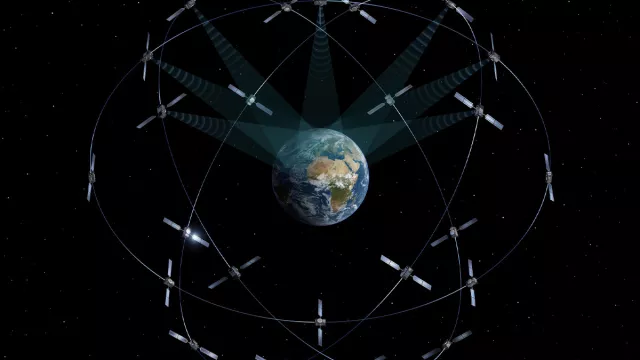Galileo delivers a global positioning service built around a constellation of 30 satellites orbiting at an altitude of 23,222 km, offering a level of accuracy better than one metre anywhere in the world.
Key information
| Mission | Provide a global satellite-based positioning system |
|---|---|
| Domain | Telecoms, navigation |
| Start date | First operational satellite launched 21 October 2011 |
| Partners | European Union, European Commission, EUSPA, ESA |
| Where | Three circular orbits at an altitude of 23,222 km (30 satellites) |
| Lifetime | Guaranteed through to 2040 |
| Status | In operation |
Key figures
- 30 satellites in constellation
- 1-metre geolocation accuracy
- 4 billion smartphones using Galileo
- 730 kg: mass of a Galileo satellite
- 12-year satellite lifetime
Key milestones
- 2023: Testing of Galileo OSNMA anti-spoofing service
- January 2023: Initial declaration of High Accuracy Service (HAS)
- August 2022: 24 operational satellites in constellation
- January 2020: Return Link Service (RLS) for distress beacons
- 15 December 2016: Galileo Declaration of Initial Services: Open Service (OS), Search & Rescue (SAR) and Public Regulated Service (PRS)
- 20 October 2011: Launch of first two operational Galileo satellites from Kourou by Soyuz
- 23 April 2008: European Parliament approves funding for Galileo
- 28 December 2005: Launch of first Galileo GIOVE-A in-orbit validation satellite
- March 2002: European Union and European Commission decide to fund project
- 1998: Galileo project kicked off
Project in brief
The Galileo programme was decided at the start of the 2000s to assure Europe’s independence in the field of GNSS (Global Navigation Satellite System). The European system would be based on a constellation of 30 satellites—24 nominal satellites and six in-orbit spares—operating alongside the U.S. GPS, Russian Glonass and Chinese Beidou systems.
Launched in tandem in 2011 and 2012, the first four Galileo satellites validated the new geopositioning system. Initial Galileo services came on stream in December 2016, with 15 operational satellites. The satellites were orbited by seven Soyuz launchers (dual launches) and an Ariane 5 launch (four satellites) from the Guiana Space Centre. From early 2017 to end 2021, one satellite was taken out of service for maintenance and three new satellites were orbited, with two launches by Ariane 5 and one by Soyuz, taking the constellation to 24 operational satellites in August 2022.
Future Galileo launches will be accomplished by two SpaceX Falcon9 vehicles in 2024 and then Arianespace’s Ariane 6 from 2025. Full Operational Capability (FOC) of the free Open Service will be declared after the next two launches, which will complete the constellation. Galileo will then be capable of supporting a broad range of applications in domains such as maritime, air and land transport, agriculture, public works, search-and-rescue operations and government, as well as applications that we use in our daily lives, notably on our smartphones.
It’s estimated that more than four billion smartphones now have a Galileo receiver (January 2024). They are interoperable and obtain a single positional fix using the four available constellations. Galileo today offers users the best positioning service there is with a horizontal accuracy of one metre. Since January 2023, it also offers a High Accuracy Service (HAS)—accurate to 20 centimetres with a convergence time of a few minutes—and in 2024 will enable signal authentication to combat spoofing.
CNES’s role
CNES was closely involved in the preliminary phases of Galileo and in defining its signals, and the agency’s Space Transportation Directorate (DTS) contributed to the Ariane 5 ES and Ariane 6 launchers’ qualification. Its Toulouse Space Centre was involved in planning and conducting satellite positioning operations in partnership with the European Space Operations Centre (ESOC), as part of ‘CNESSOC’ up to 2018. CNES is currently helping to assess Galileo performance within a consortium working for EUSPA and operates the Galileo Search and Rescue (SAR) service centre that collects and transmits alerts from emergency locator beacons all over the world, relayed by the Galileo satellites.
Contacts
Head of Navigation Programme
Marc Jeannot
E-mail: marc.jeannot at cnes.fr
GEMOP (Galileo & Egnos Monitoring of Performance, EUSPA) grant Project Leader
Julien Colasson
E-mail: julien.colasson at cnes.fr
Project news



